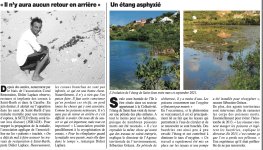JEK
Senior Insider

There will be no return back
For years, notably through the Coral Restoration Association, Didier Laplace observes, restores and implanted corals in Saint-Barth and in the Caribbean. Last June, he alerted on the appearance in the waters of Saint-Barth for a deadly disease for thirty species, the SCTLD (Stony Coral Tis- Sue Loss Disease) (JSB1428). To stop the spread of the disease, the association applies amoxicilin on affected "patients". "We are already struggling to advance restoration works in Saint-Barth, Plate Didier Laplace. Fortunately, Branchus corals are not infected, which is a good thing. Naturally, there is nothing one can do. We must be aware that by losing these reefs, we lose all the things associated with it. Like the cleaner fish. There will be no back and it's hard to swallow. We are told to save what's important, but everything is important! The association proceeds parallel to the cryogenization of corals. "To reimplant them when the disease will be passed, but it lasts in time," says Laplace Didier.
An asphyxiated pond
The evolution of the pond of Saint-Jean between March and September 2021.
The only wetland of the island to be located in a sector owned by the community, the pond of Saint John has just traveled a more harmful period. At the very least for its inhabitants, since many dead fish have been identified. "He reproduced the same as before work is undertaken," said the Director of the Territorial Environment Agency, Greal Sébastien. In times of Drought, there is less water. Fish consume all oxygen and eventually die. »
In this case, if the phenomenon is natural, it is here mainly linked to the fact that the pipes that allow the water to circulate and to renew themselves clogged. Bacteria have gradually invaded the pond and helped reduce the oxygen level. "A job has been quickly put in place on the pipes and a pump has been installed for reoxygenate, "Reassures Sebastien Greaux.
In addition, territorial agents intervened in order to pick up the bodies of dead fish. Essentially to avoid 2013 Hécaslade. "The birds come to eat fish and ingest bacteria, explains the director. In 2013, that's how we lost our pelicans. An experience that he was preferably not to renew.




